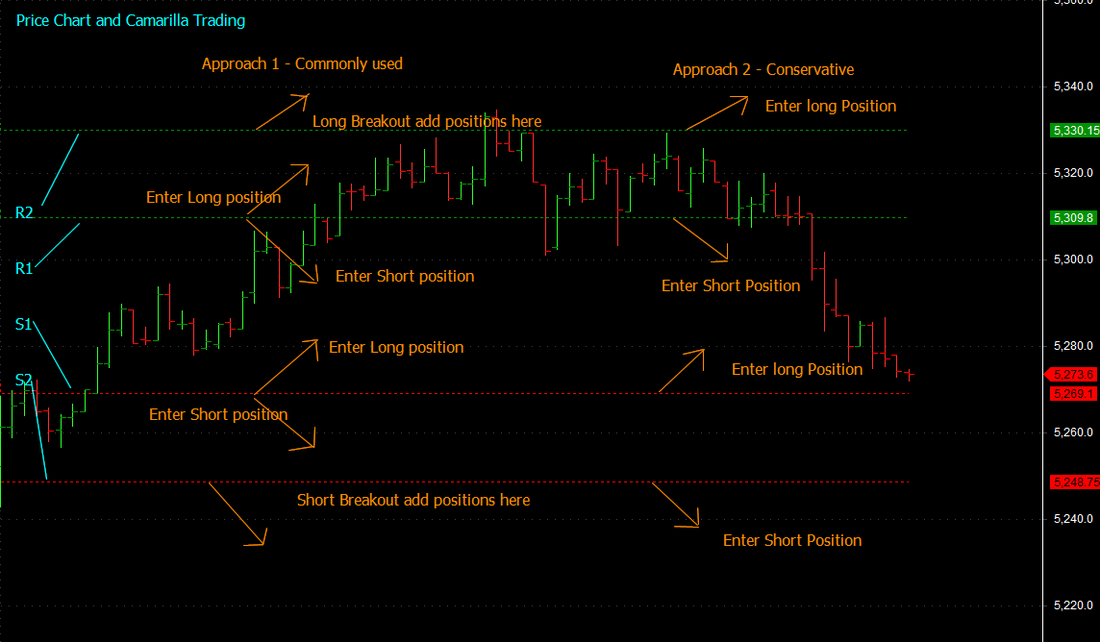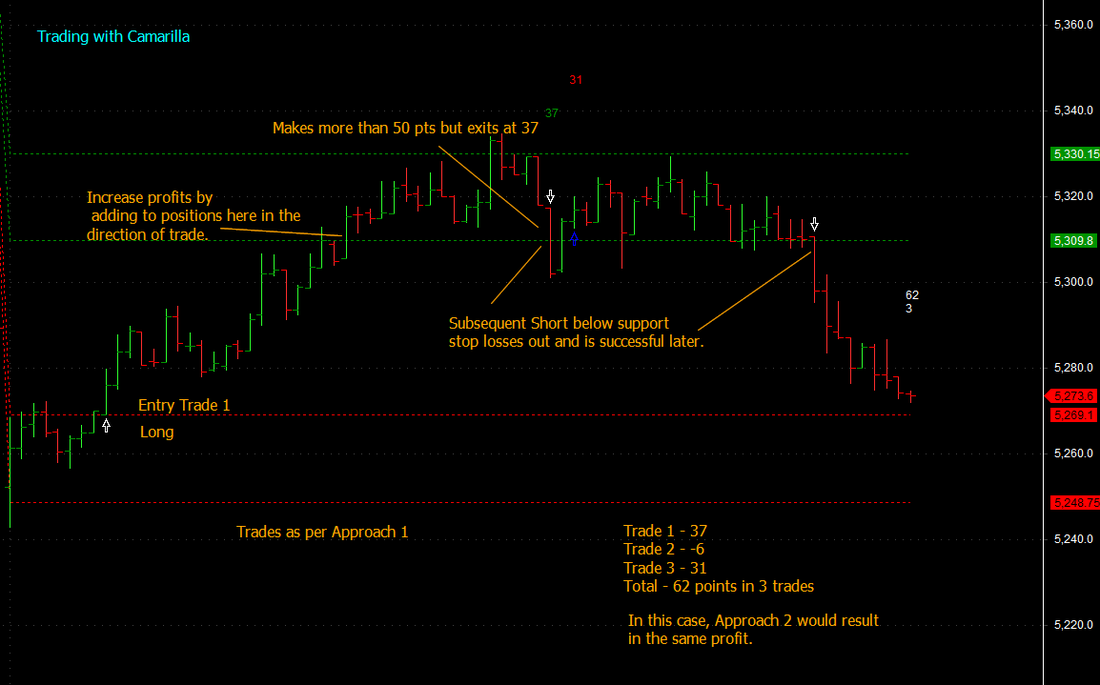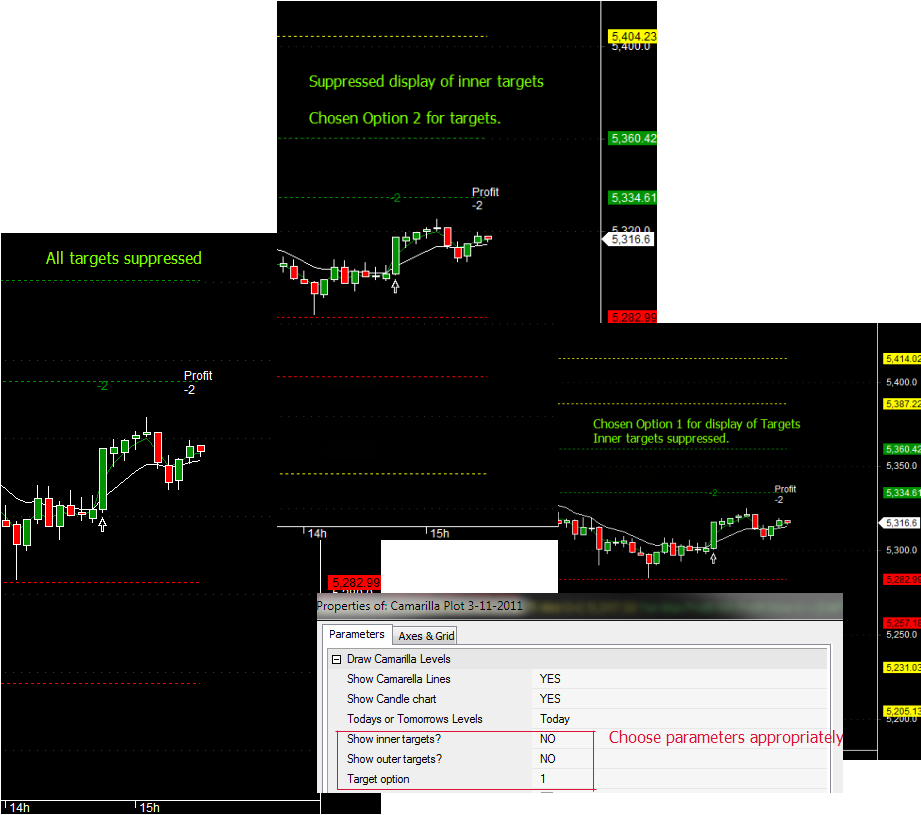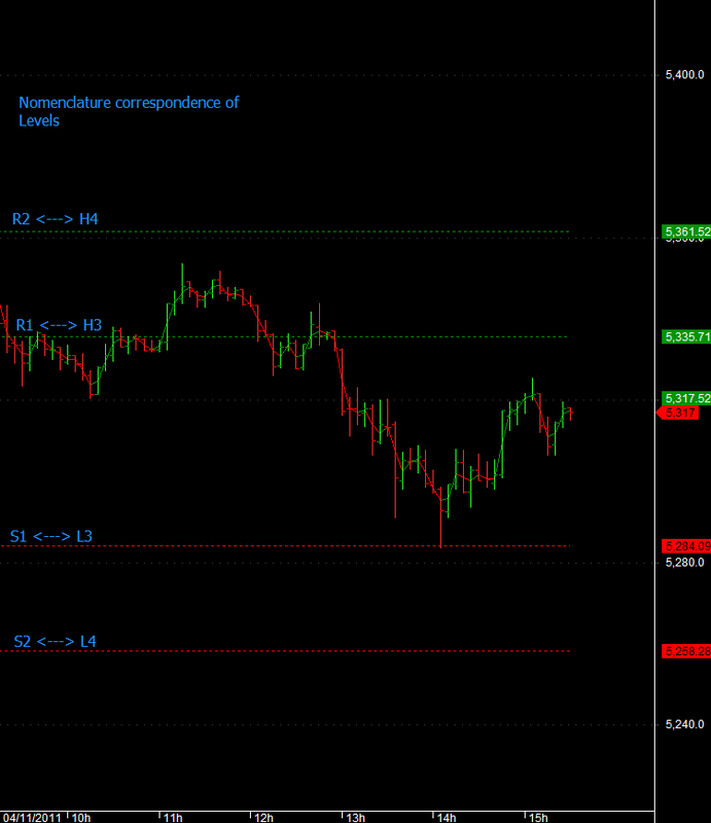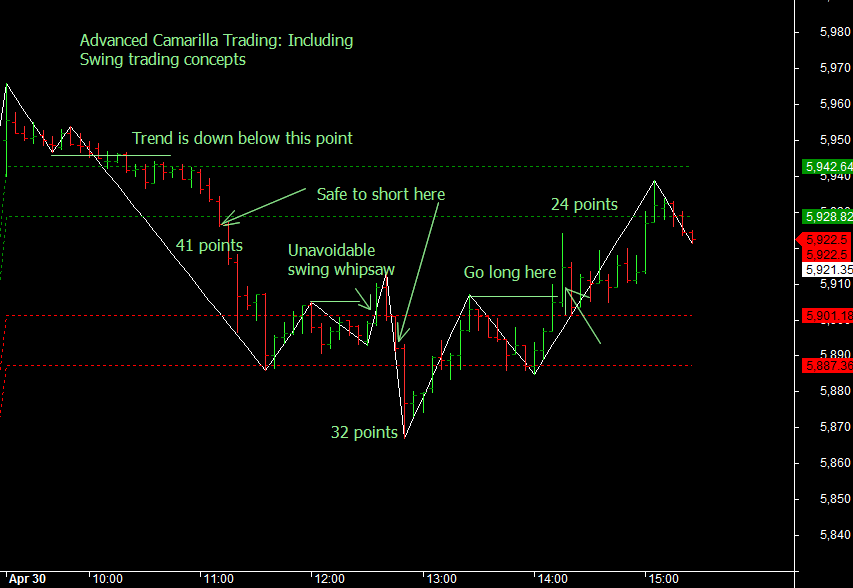| TradeWithMe |
11. Camarilla Trading
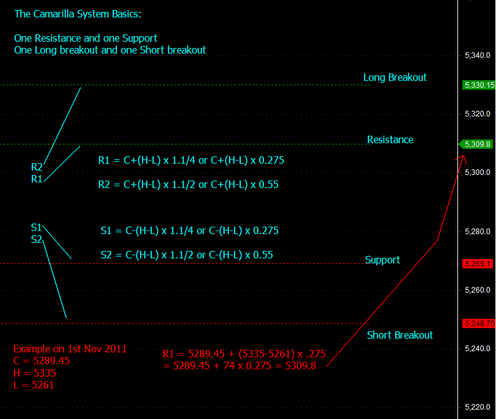
We discuss here the fundamental approach of Camarilla trading and also present useful Amibroker AFL's that are immediately usable.
The Camarilla based trading system is a level based classic system which postulates that market moves around a mean level which is determined by the previous days prices. There have been various stories of how it was invented, and we wont get into that but explore the system straightaway. For a trader who wants to trade consistently with decent and moderate profits, this is one of the most consistent systems which works well for high volume financial instruments. It works well with the various indices and particularly in the forex market too.
The market mean for the trading day is the close of the previous day and trading levels are derived from the High and Low of the previous day.
There are four key levels that are important:
The resistance - the price to which an initial long will be successful.
The long breakout - the price above which the market is in a major long trend
The support - the price to which an initial short will be successful and,
The short breakout - the price below which a short trend will occur.
The above is the basic explanation of the Camarilla levels. Most internet resources tend to complicate the definition to make it unusable to a large extent.
See the chart aboveand the definitions of the Resistance R1 and R2 and Support levels.S1 and S2.
If H, L and C are the high, low and close of the previous day, the factors that go into it are:
Price momentum = High - Low = lets call it momentum.
Market mean = Close = Mean.
Resistance/Support factor = RS = 0.275 an optimized number.
Breakout factor = BF = 0.55, another optimized number.
So Resistance = Mean + Momentum x RS
and Support = Mean - Momentum x RS
or R1 = C + (H-L) x 0.275
and S1 = C - (H-L) x 0.275
Likewise, the breakouts are nothing but
Long Breakout = Mean + Momentum x BF
Short Breakout = Mean - Momentum x BF
or R2 = C + (H-L) x 0.55
and S2 = C - (H-L) x 0.55
You can see that by reading the principles in the way described, it is intuitively possible to understand how the inventor wanted to express himself.
Note the relationship between the Breakout factor and the Resistance/Support factors. The former is double the value of the latter. In fact, if you examine more closely, there is a relationship between Camarilla levels and the Fib Levels too. The Resistance level for example is very close to the 61.8% retracement level.
11.1 Trading with the Camarilla Levels
There are two ways of trading the Camarilla levels as shown in the chart below.
Approach 1 -
Long positions entered ABOVE support (S1) and ABOVE resistance (R1) and ABOVE long breakout (R2)
Short postions entered BELOW support (S1) and BELOW resistance (R1) and BELOW short breakout (S2)
and Approach 2 -
Long positions are entered ABOVE support (S1) and ABOVE long breakout (R2) only and
Short positions are entered BELOW resistance (R1) and BELOW short breakout (S2) only.
Whats the difference. Approach 2 will generally give more modest profitable trades, but it avoids possible whipsaws that occur sometimes between resistance and breakout levels and support and breakout levels. You can experiment and use either of these approaches. If you are able to introduce noise cancellation for whipsaws, then Approach 1 remains more superior.
Approach 1 -
Long positions entered ABOVE support (S1) and ABOVE resistance (R1) and ABOVE long breakout (R2)
Short postions entered BELOW support (S1) and BELOW resistance (R1) and BELOW short breakout (S2)
and Approach 2 -
Long positions are entered ABOVE support (S1) and ABOVE long breakout (R2) only and
Short positions are entered BELOW resistance (R1) and BELOW short breakout (S2) only.
Whats the difference. Approach 2 will generally give more modest profitable trades, but it avoids possible whipsaws that occur sometimes between resistance and breakout levels and support and breakout levels. You can experiment and use either of these approaches. If you are able to introduce noise cancellation for whipsaws, then Approach 1 remains more superior.
11.2 Real Trades with the Camarilla levels
See the trades for the same price chart above plotted in the chart below.
Important approach to increase profits: Add to positions when a new entry position is crossed
Long initiated at S1. Add to positions at Long entry at R1 and add more at cross of R2.
Short initiated at R1. Add to positions below S1 and below R2.Exit based on targets and trailing stop losses.
Setting up exit targets. While the system does suggest targets for longs and shorts, you must set up your target strategy based on a risk reward approach.Example:If your stop loss is 15 points while trading the Nifty. Your risk reward ratios can be 1:1, 1:2, 1:3 and 1:4. So your target exits are 15 pts, 30 pts, 45 pts and 60 pts. Use risk reward levels crossovers as trailing stop losses. Which means you fail to cross 1:3 and price falls, you exit at 1:2 level i.e. 30 points. Makes trading really simple!Another approach is to set up trailing stop losses (SL) at a standard level of say 20 - 25 points. Increasing trailing SL's increase your ability to stay with the trade but reduces the profit on exit. Its best to combine target based and trailing stop loss based exits through your own experimentation.
Important approach to increase profits: Add to positions when a new entry position is crossed
Long initiated at S1. Add to positions at Long entry at R1 and add more at cross of R2.
Short initiated at R1. Add to positions below S1 and below R2.Exit based on targets and trailing stop losses.
Setting up exit targets. While the system does suggest targets for longs and shorts, you must set up your target strategy based on a risk reward approach.Example:If your stop loss is 15 points while trading the Nifty. Your risk reward ratios can be 1:1, 1:2, 1:3 and 1:4. So your target exits are 15 pts, 30 pts, 45 pts and 60 pts. Use risk reward levels crossovers as trailing stop losses. Which means you fail to cross 1:3 and price falls, you exit at 1:2 level i.e. 30 points. Makes trading really simple!Another approach is to set up trailing stop losses (SL) at a standard level of say 20 - 25 points. Increasing trailing SL's increase your ability to stay with the trade but reduces the profit on exit. Its best to combine target based and trailing stop loss based exits through your own experimentation.
11.3 Setting up exit targets based on Camarilla levels
Its possible to set up exits based on the support/resistance and breakout levels simply as follows. These are indicative targets and its best to follow the target approach given in the previous section:
High Target 1 = R2 + 1.005 x R2 (.05% level)
High Target 2 = R2 + 1.01 x R2 (.1% level)
Low Target 1 = S2 / (1+.005) (0.05% level)
Low Target 2 = S2/(1+0.01) (0.1% level).
Likewise you can peg targets for longs and shorts starting at S1 and R1 respectively as:
Long Target 1 = S1 + 0.65 * (R1-S1) and
Long Target 2 = S1 + 0.85 * (R1-S1) and
Short Target 1 = R1 - 0.65 * (R1-S1) and
Short Target 2 = R1 - 0.85 * (R1-S1)
Alternative targets for highs and low breakouts are -
BTHigh = High/Low x Close
BTLow = Low/High x Close
In conventional common references, the R1, R2 and S1 S2 levels described here are correlated to H3, H4 and L3,L4 levels respectively or to R3,R4 and S3,S4.
An AFL for trading with the Camarilla system is attached below.
We will modify this to suppress some of the unneccessary target lines.
Rev 7.1.2011 - Parameters added to allow user to display or suppress inner and outer targets. Please Choose the target option when Outer target parameter is set to display targets. Also you can now vary the CAM parameters themselves. Use with care, as the standard levels work well in most situations.
Rev 30.11.2014 - Bar repainting within current time period fixed and improved logic for whipsaw removal implemented. Parameters introduced to control the period of the slow and fast moving lines and a distance from crossover in terms of bars to avoid delayed signals.
High Target 1 = R2 + 1.005 x R2 (.05% level)
High Target 2 = R2 + 1.01 x R2 (.1% level)
Low Target 1 = S2 / (1+.005) (0.05% level)
Low Target 2 = S2/(1+0.01) (0.1% level).
Likewise you can peg targets for longs and shorts starting at S1 and R1 respectively as:
Long Target 1 = S1 + 0.65 * (R1-S1) and
Long Target 2 = S1 + 0.85 * (R1-S1) and
Short Target 1 = R1 - 0.65 * (R1-S1) and
Short Target 2 = R1 - 0.85 * (R1-S1)
Alternative targets for highs and low breakouts are -
BTHigh = High/Low x Close
BTLow = Low/High x Close
In conventional common references, the R1, R2 and S1 S2 levels described here are correlated to H3, H4 and L3,L4 levels respectively or to R3,R4 and S3,S4.
An AFL for trading with the Camarilla system is attached below.
We will modify this to suppress some of the unneccessary target lines.
Rev 7.1.2011 - Parameters added to allow user to display or suppress inner and outer targets. Please Choose the target option when Outer target parameter is set to display targets. Also you can now vary the CAM parameters themselves. Use with care, as the standard levels work well in most situations.
Rev 30.11.2014 - Bar repainting within current time period fixed and improved logic for whipsaw removal implemented. Parameters introduced to control the period of the slow and fast moving lines and a distance from crossover in terms of bars to avoid delayed signals.
| camarilla_plot_30-11-2014.afl | |
| File Size: | 7 kb |
| File Type: | afl |
11.4 Alternative strategies for setting up Camarilla levels
(Contributed by JR Julius - http://everydayprofits.blogspot.in/)
#Approach1 - Handling Gap ups
Few days the Open will be Above H4 or Below L4 Due to GAP. In these situations I put the today open in the place of previous day close in the Camarilla formula. That means Close is replaced by Open of the day the gap up occurred.
#Approach2 - Alternative entries after opening
You missed the entries during opening. Take H/L/C as the values after one hour. Use the R2 (H4) and S2 (L4) levels for trading only. Which means you go long above R2 and short below S2. Thats it. And work with a 1:1 risk reward trade.
Alternative comment : (Abnash): Consider Camarilla set ups with 2 hours and 4 hours and even weekly/monthly levels and you can get trading opportunities there too. Paper trade first.
#Approach3 - Market opens at the close of the previous day i.e. the mid point for today
Market Opens in the Central Point. Means In between L1 & H1. H3 May Act as Buy. L3 May Act as Sell. It can be done with the guidance of experts using few technical indicators. This one is weird may damage total understanding about camarilla, but if one watch the camarilla levels alone for few months will automatically understand what I am saying here.
Comment (Abnash): The method described in this section uses R1/H3 as a buy or sell in the right context.
Few days the Open will be Above H4 or Below L4 Due to GAP. In these situations I put the today open in the place of previous day close in the Camarilla formula. That means Close is replaced by Open of the day the gap up occurred.
#Approach2 - Alternative entries after opening
You missed the entries during opening. Take H/L/C as the values after one hour. Use the R2 (H4) and S2 (L4) levels for trading only. Which means you go long above R2 and short below S2. Thats it. And work with a 1:1 risk reward trade.
Alternative comment : (Abnash): Consider Camarilla set ups with 2 hours and 4 hours and even weekly/monthly levels and you can get trading opportunities there too. Paper trade first.
#Approach3 - Market opens at the close of the previous day i.e. the mid point for today
Market Opens in the Central Point. Means In between L1 & H1. H3 May Act as Buy. L3 May Act as Sell. It can be done with the guidance of experts using few technical indicators. This one is weird may damage total understanding about camarilla, but if one watch the camarilla levels alone for few months will automatically understand what I am saying here.
Comment (Abnash): The method described in this section uses R1/H3 as a buy or sell in the right context.
11.5 Modified Camarilla levels
The current CAM levels are derived with an inner CAM parameter of 0.275 (1.1/4) and an outer parameter of 0.55 (1.1/2). Have you ever thought what would happen if you changes these parameters? Does it help? Check this out by varying the inner and outer parameters. There is merit in considering values ranging from 0.26 upto 0.32 for the inner CAM levels. You may experiment using the newly added feature in the AFL where you can continuously vary the parameters. It is advisable that you use this when you can compare profitability levels accross multiple days.
11.6 Using Point and Figure Charts
11.7 Camarilla and Mentored trading
A more refined version of Camarilla trading is one where the principles of swing trading are used to ensure that trades are entered based on breakouts from swings or on trend confirmations from the swings. This version is available for customers who opt for Mentored trading or for a flat $ 100 charge. The sample below shows how the trades will look there - the actual system shows trades at the points highlighted.
|
Want more information ? Get in touch with us through the contact form : (click here)
|
|
